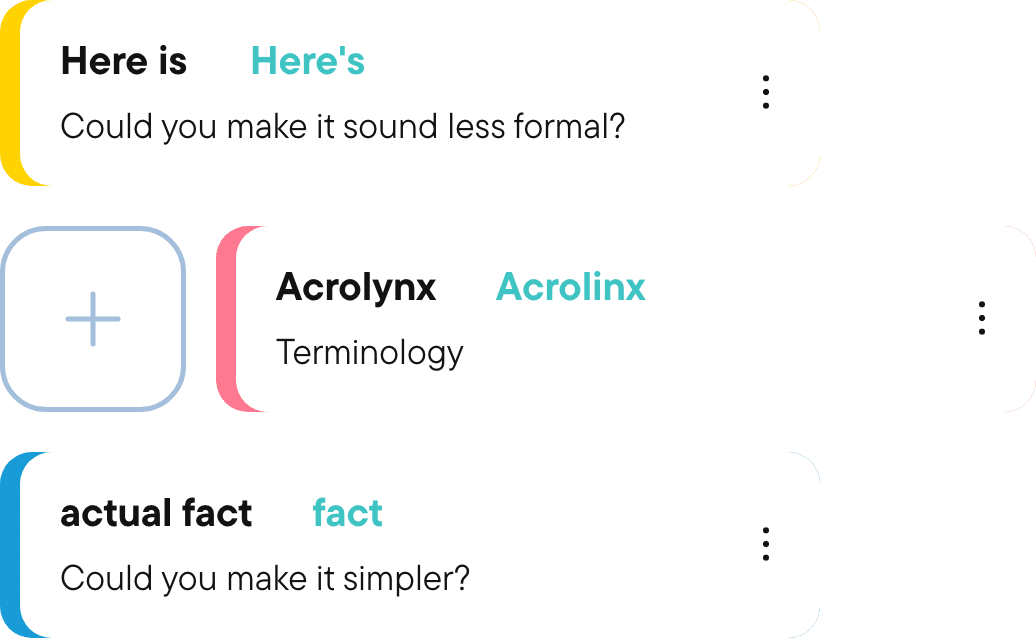Common Questions

Explore the hub
We answer some common questions
Are you seeking an answer to a question about inclusive language? We don’t claim to have all the answers, but maybe we can connect you with someone who does. In the meantime, Acrolinx has answered a few common questions that we’ve received along the way.
Why is diversity and inclusion good for business?
Diversity and inclusion (D&I) is just one of many priorities a business can have to become adaptable to societal change. We’ve recently witnessed how rapidly the world can change! When we think about how to build a resilient business that rides the waves of social change and unrest, diversity and inclusion contributes to that resilience. Thankfully, many leaders of great companies (big and small) are beginning to understand that.
What’s the difference between inclusive language and political correctness?
Interestingly, the Oxford dictionary defines political correctness very similarly to how we might describe inclusive language. It’s the avoidance of forms of expression or action that are perceived to exclude, marginalize, or insult groups of people who are marginalized or discriminated against.
At Acrolinx, we see inclusive language as more than just avoiding offense. It’s a communication style that is genuinely curious about how to talk to and about our fellow humans respectfully. Inclusive language symbolizes acceptance, allyship and a commitment to seeing human differences through a lens of collaboration and a catalyst for growth. Inclusive language encourages human flourishing. Which means the bar is set higher than simply avoiding discrimination.
Just like learning a second, or third language like French or Farsi, inclusive language broadens our horizons. One may choose to see it like acquiring a new language — knowing more languages gives us more ways to describe the beauty and complexity of human expression.
It’s also possible that political correctness causes a mistake-intolerant culture because it closes down conversations. When done well, inclusive language keeps curiosity alive and values connection with all the inevitable mistakes over censorship.
What’s performative allyship and how do we avoid it?
Performative allyship is surface-level activism or statements that are not backed up by a deeper initiative that’s sustainable long term. It’s saying you’re open and willing to change, yet you’re actually unwilling to challenge the status quo behind the scenes. We can suppose that individuals or groups of people are more likely to engage in performative allyship because they are afraid of what they’ll lose when they’re not benefiting from maintaining the status quo.
You can avoid performative allyship by:
- Bringing in an external reviewer to assess what you can realistically achieve in what time frame so you don’t over promise and under deliver when it comes to diversity, equity and inclusion.
- Defining clear objectives before you write a public statement about your commitment to the cause because otherwise, your organization is being held accountable to bold statements that have no plan.
- Affiliating your organization with other businesses to keep you motivated and hold you accountable.
- Most importantly, leadership needs to be involved. There’s only so far you can get with grass-roots initiatives!
What do I do if I make a mistake and offend someone?
Fear of making mistakes is understandable, but it shouldn’t get in the way of trying your best to communicate respectfully. If you find that you’ve misgendered someone or laughed at a joke that perpetuates stereotypes, the simplest thing to do is to apologize, acknowledge the more inclusive choice of wording, and pick up the conversation where you left off. Easy!
Non-inclusive language in written content can be harder to detect due to the velocity and volume of content created in organizations. Acrolinx suggests using technology to help align all your company content to your inclusive language guidelines so you can rest assured that every piece of published content signals belonging to all people!
How do we decide what’s inclusive when building out our inclusive language content guidelines?
Building your inclusive language guidelines should be a collaborative process that involves as many different identities as possible.
Acrolinx built its inclusive language solution guided by:
- Social organizations: Following best practices based on organized information from diversity groups.
- Educational research: Reviewing published research from respected universities across the globe.
- National influence: Including guidelines from the United Nations and other government alignment agencies.
We encourage you to stay up to date as language evolves, and check in with trusted resources to make sure your inclusive language guidelines are still current and guided by the language used among identity communities.
Is the singular pronoun “they” really grammatically correct?
With greater attention on gender-neutral pronouns, we sometimes hear that the singular “they” pronoun feels awkward, suggesting that it’s not grammatically correct.
As it happens, the Oxford English Dictionary traces the singular “they” back to 1375, where it appears in the medieval romance “William and the Werewolf” (Baron. D, 2018).
But guess what? It may be that you already use the singular “they” pronoun in your daily life. Take these examples from our Grammar Guide for Busy People:
- “Someone left their coffee cup on my desk, gross!”
- “I called a new dog walker today and booked Fluffball in for Thursday morning.”
“Great. Did you also let them know how to unlock the keybox?” - “I heard we’re getting a new intern. Do you know when they start?”
If it feels awkward, that’s because 18th-century grammarians said that English grammar should conform to Latin grammar. It’s simply a matter of what we’re familiar with — not that the singular “they” pronoun is grammatically incorrect.
Want to know more? Read our blog A Guide to Gender Neutral Language in Business Writing. For ideas on how other languages deal with gender neutral pronouns, this blog by Babbel is a great introduction.
Ready for content success?
See how our AI capabilities help you create and maintain high-quality content in our demo.

